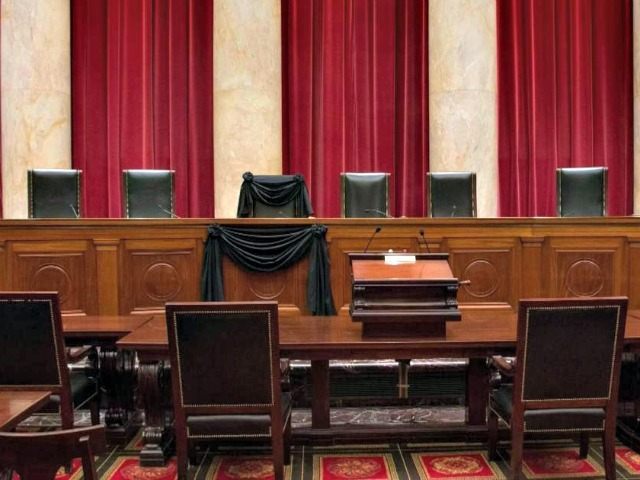WASHINGTON—On Monday, the Supreme Court opened a daily session without Justice Scalia serving on the Court for the first time in almost 30 years, and Chief Justice John Roberts took a few somber moments to speak about the thing foremost on the minds of many present: the black-draped chair next to the chief justice’s right hand.
It was a jarring sight to those seated in the courtroom for 40 minutes or more before the clock struck 10:00 AM, the appointed time for the Court’s first daily session in its two-week February sitting. The courtroom always looks the same, and frequent attenders are accustomed to the unchanging details of the chamber.
But not now. As the senior associate justice, Scalia sat to the immediate right of the chief justice, who sits in the center chair at the Court’s nine-member bench. Justice Scalia’s vacant chair was draped in a black woolen crepe, as was the section of the bench immediately in front of his chair. The ornate entrance to the courtroom was draped in identical fashion, visible throughout the Supreme Court’s Great Hall.
Once the Court was called to order by the court marshal, Chief Justice Roberts paid tribute to Justice Scalia. “We remember his incisive intellect, his agile wit, and his captivating prose,” Roberts said. He lauded both Scalia’s “irrepressible spirit” and his contribution to the law, authoring 292 majority opinions. (The Court later corrected this statement: Scalia had authored 282 opinions; Roberts’s statement included a clerical error.)
“He was also known on occasion to dissent,” Roberts added, to the laughter of an audience of lawyers who are very familiar with Justice Scalia’s famous—and famously entertaining—dissenting opinions.
The chief justice noted a number of facts about Scalia, including that he “argued his first and only case before the Supreme Court in 1976. He prevailed, establishing a perfect record before this Court.”
Roberts also explained that the black decor “signifies a period of mourning the loss of our friend and colleague.” The tradition began with the 1873 death of Chief Justice Salmon Chase. It will remain in place for 30 days from Scalia’s death, which occurred February 13, at which time the justices will all move up one seat in ranking of seniority, leaving the far-left seat on the bench (far right from the vantage point of someone sitting in the audience) until a new justice is confirmed, presumably in 2017.
Antonin Scalia was “our man for all seasons,” Roberts said, “and we will miss him beyond measure.”
Ken Klukowski is legal editor for Breitbart News. Follow him on Twitter @kenklukowski.

COMMENTS
Please let us know if you're having issues with commenting.